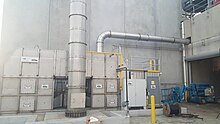Materials for Ducts
– Ducts can be made out of various materials including galvanized steel, aluminium, polyurethane and phenolic insulation panels, fiberglass duct board, and flexible ducting.
– Galvanized steel is the most common material used in ductwork fabrication, providing durability and rust resistance.
– Aluminium ductwork is lightweight and easy to install, allowing for custom or special shapes to be fabricated.
– Polyurethane and phenolic insulation panels eliminate the need for additional insulation and have factory applied aluminium facings.
– Fiberglass duct board provides built-in thermal insulation and sound absorption.
– Flexible ducting is made of flexible plastic over a metal wire coil and is convenient for attaching supply air outlets to rigid ductwork.
Types of Ducts
– Galvanized steel ducts are commonly used and can be lined with faced fiberglass blankets or wrapped externally with fiberglass blankets for insulation.
– Aluminium ducts are lightweight and can be easily fabricated into custom shapes.
– Polyurethane and phenolic insulation panels eliminate the need for additional insulation and can be installed in a single step.
– Fiberglass duct board panels provide built-in thermal insulation and sound absorption.
– Flexible ducting is made of flexible plastic over a metal wire coil and is suitable for short runs and minimized turns.
Additional Ducting Components
– Besides the ducts themselves, complete ducting systems contain other components such as dampers, diffusers, grilles, registers, and insulation.
– Each component plays a specific role in the functioning of the ducting system.
– Proper selection, installation, and regular maintenance of these components are essential for optimal performance.
Specialized Ducting Features
– PVC low-profile ducting is a cost-effective alternative to steel low-profile ducting, commonly used in apartment and hotel ventilation.
– Waterproofing is important to protect ductwork from moisture damage, and various coatings such as aluminium/zinc alloy or multilayer laminate can be used.
– Vibration isolators are inserted into the ducts to reduce noise and vibration transmission, allowing the air handler to vibrate without affecting the attached ducts.
– Take-offs are fittings used to divert a small portion of the flow in the main duct into branch ducts, and they can be fitted into round or rectangular openings cut into the wall of the main duct.
Inspection, Sealing, and Leaks
– Regular inspection of ductwork is recommended to ensure proper functioning and identify any issues such as water damage or biological growth.
– Sealing leaks in air ducts reduces air leakage, optimizes energy efficiency, and controls the entry of pollutants into the building.
– Signs of leaky or poorly performing air ducts include higher utility bills, difficulties in heating or cooling certain spaces or rooms, and ducts located in areas prone to leaks such as attics or crawl spaces. Source: https://en.wikipedia.org/wiki/Duct_(HVAC)
Ducts are conduits or passages used in heating, ventilation, and air conditioning (HVAC) to deliver and remove air. The needed airflows include, for example, supply air, return air, and exhaust air. Ducts commonly also deliver ventilation air as part of the supply air. As such, air ducts are one method of ensuring acceptable indoor air quality as well as thermal comfort.



A duct system is also called ductwork. Planning (laying out), sizing, optimizing, detailing, and finding the pressure losses through a duct system is called duct design.
